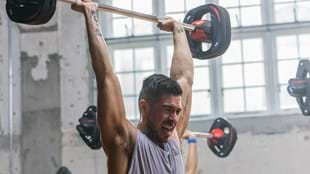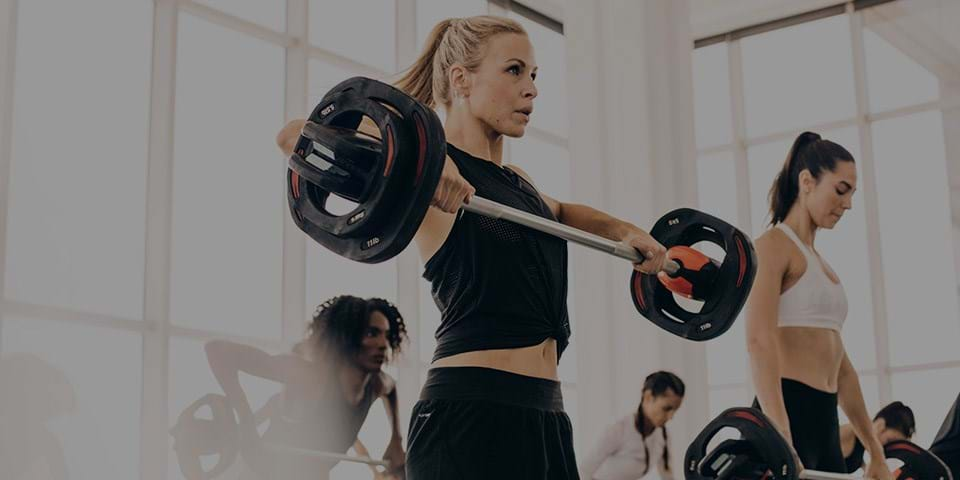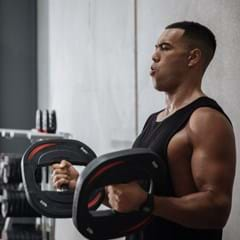We all know that you don’t get results when you sit in your comfort zone, but is there an ideal degree of “discomfort”? When it comes to how much exercise should hurt, says Bryce Hastings, Physiotherapist and Les Mills Head of Research, there are no hard and fast rules. For the most part it depends on the type of suffering – put simply, while it’s okay for exercise to feel uncomfortable, it should never be painful.
“Too often people don't distinguish between the discomfort that comes from fatigue and the feeling of pain,” says Hastings.
Unfortunately, the confusion between fatigue and pain can be off-putting if you’re only at the beginning of your exercise journey. “When you’re just starting out you sweat, you get an increased heart rate and you feel uncomfortable – all of this is the stress response that comes from exercise,” says Hastings. It’s not until you become accustomed to regular training that you learn this stress and fatigue is part of the deal. Your body embraces it because you know that it goes away quickly.
Fatigue is your friend. Transformation happens when you push your body into the fatigue zone.
Hastings explains there are five exercise intensity zones, and a sound weekly workout regime involves spending time in each zone. Ideally, you should be exercising at a moderate to hard intensity (where the discomfort of fatigue probably sits between 6.5 and 8.5 out of 10), as this will help improve aerobic fitness and promote fat burn. Pushing your body to its maximum training zone (where the discomfort of fatigue hits 8.5 to 10 out of 10) will help you develop maximum performance, but you only want these spikes of intensity a couple of times a week. He also cautions that feeling flogged during exercise is not the only measure of a workout’s value – while exercising at a very low intensity is unlikely to generate fatigue, low intensity activities like yoga and core training can improve overall health and help recovery.
If it’s not fatigue-based discomfort, it’s a pain.
When it comes to distinguishing between types pain, there are two things you can do:
- Mentally split yourself in half and evaluate where it hurts. If you have pain in the same place on both sides and it’s the same type of pain, then it’s probably delayed onset muscle soreness (or DOMS). In most cases this is nothing to worry about. You can check out some tips on how to deal with it here.
- If you have a specific point of pain that’s on one side of your body but not on the other, and that pain is above 3 out of 10, and interfering with your function, then you’re possibly suffering an injury. In this situation we suggest you seek professional advice.
It’s the location of the pain that matters most.
The benefits of your training come from discomfort in the muscles, not the joints. So if you’ve got any joint pressure or discomfort it’s an issue. Let’s take squats for example. Squats are all about working your quads and glutes, so if you’re squatting and your quads start getting sore that’s to be expected. But if you start to get a lot of pressure in your lower back that’s a warning sign, because that’s not the intended target. It indicates that no longer is the soreness born from muscle fatigue, it’s possibly pain coming from compressed joint tissue. It’s the same as if you’re doing the overhead press and suddenly your neck starts getting sore – that’s not the intended target, so could be an issue.
How much should you suffer?
The amount of suffering you subject your body to should depend on the exercise you’re doing. If you’re using a leg press machine all you need to worry about is pressing, so you are safe to go to volitional failure – which means going to the point where you actually can’t push anymore. But if you’re doing weighted squats it’s a different story. Fatigue will often make things more difficult when you’re at the bottom of the squat, which can be dangerous if you encounter failure at this point, so normally you might finish your set at 85 percent fatigue. You can push the fatigue point further out if you have a safety mechanism such as a spotter, someone who stands over you ready to take the load if needs be.
Warning signs: when to take action.
The major warning signs are unilateral (one-sided) pain, any joint pressure or discomfort, and sudden onset sharp pain. And sometimes sudden onset weakness can be sign that something is not right.
Hastings says these are all warning signs: “Pressure in the front of the knee while you squat, pain in your elbows when you grip, pressure in your neck or upper back when you’re doing an overhead press, pain at top of the shoulder while you bench press.”
Of course muscle and joint pain are not the only discomfort people associate with exercise. I am thinking about that awful gasping sensation that comes when you just can’t get enough air in your lungs, or when you’ve raised your heart rate so high it feels like it will pump its way past your ribs and out of your chest. But Hastings says that if you’re fit and healthy you should be able to push your body to its max – reaching high levels of exertion without any significant concerns.
His advice? Don’t shy away from discomfort but always think about what your objective is, and if it feels slightly off, it probably is.
PAIN: WHAT YOU NEED TO REMEMBER
- It’s important to identify the difference between fatigue and pain.
- Fatigue is good – as transformation happens when your body hits the fatigue zone.
- It’s okay for exercise to cause discomfort in your muscles – but you shouldn’t feel any discomfort in your joints.
- Post-workout pain that is equal on both sides of the body is most likely delayed onset muscle soreness (DOMS).
- If you suffer from one-sided pain, joint pain or sudden onset sharp pain seek professional advice.
Learn more about muscle soreness here.








